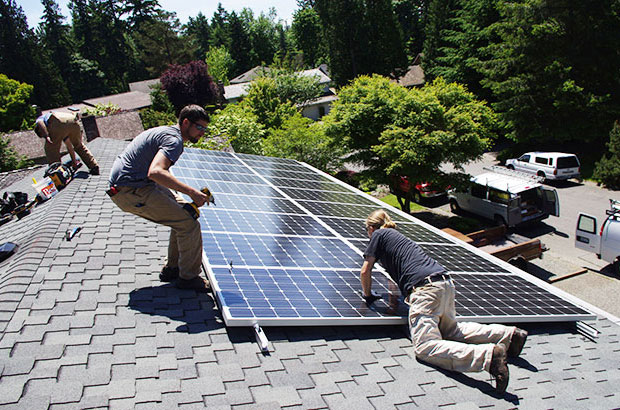Despite its early prominence as a high-profile ballot campaign less than ten years ago, Washington’s Energy Independence Act (better known by it’s ballot number, I-937) seems to fly under the radar. Perhaps it’s because this groundbreaking clean energy law is working so well for Washington businesses, workers and utility customers. This anonymity is about to change.
Jobs and economic development, better energy and a foundation for more.
Passed in 2006, I-937 created a Renewable Portfolio Standard (RPS), requiring Washington utilities to generate at least 15% of their electricity from new, non-hydro, renewable sources such as wind and solar. I-937 also requires that Washington utilities invest in all cost-effective energy conservation, ensuring electricity is used as efficiently as possible.
Washington businesses, workers and utility customers making great strides through I-937. New renewable generation makes Washington’s grid more diverse and resilient, while communities, mostly east of the cascades, have seen over $8 billion in investment and over 3,000 construction and operations jobs. The clean energy and efficiency investments from I-937 will reduce carbon pollution by nearly 8 million tons by 2020, the most successful state climate policy currently on the books. I-937 has built the foundation for an even cleaner, more efficient and lower cost electricity system – but we have to think holistically and plan for decades to come.
Ready to ramp up
The trouble facing our clean energy future is that the new renewables requirement of I-937 caps out in 2020. Past that date, utilities must only maintain renewables as 15% of their load. In order to continue progressing Washington forward, to keep up with our competitors in the clean energy economy and best serve the grid of the future, we must have a plan to increase new renewable energy resources beyond this decade. Clean energy and salmon advocates have long been calling for a comprehensive post-2020 plan as opposed to short-term modifications and one-off carve outs. If we do this right, Washington would benefit from new jobs and cleaner air--it's a great opportunity.
The Clean Energy Choice Act (HB 2073)
This year, we can seize the clean energy opportunity. The vision laid out in a new, comprehensive approach to reforming I-937, called the Clean Energy Choice Act (HB 2073), addresses the needs of utilities to serve load at low costs while ensuring that every time a fossil fuel contract comes due, it is replaced by clean energy. Megawatt by megawatt, the Clean Energy Choice Act will transition our fossil-powered grid to one served by renewable energy. The bill is a responsible submission to the clean energy debate. It deserves a hearing and vote, and should be the starting point for any post-2020 proposal going forward.
Opponents of clean energy are on the attack
As a comprehensive bill that advances the clean energy economy, the Clean Energy Choice Act is unique among 937 bills this session. Weakening I-937 is one of the featured platforms of the Senate Republican’s “new energy and carbon emissions reduction plan.” The “centerpiece” of the package, SB 5735, masquerades as a carbon pollution reduction bill but its real effect would be to eliminate the market for new renewable resources like wind and solar. The bill would allow utilities to spend a small amount of money in ill-defined “carbon emissions reduction investments” instead of having to comply with I-937.
The prime proponent of package, Senator Doug Ericksen (R–Ferndale), may have good intentions about reducing emissions, but trying to shoehorn unnecessary new compliance options for utilities without balancing the policy with additional new renewables undermines our most successful carbon pollution policy. Washington cannot reach its carbon pollution targets, nor be a clean energy leader by limiting its most successful policy. Instead, Senator Ericksen should start the discussion about growing Washington’s clean energy economy with the Clean Energy Choice Act.
I-937 is perhaps better remembered as an economic development or public health policy than solely an energy program. While it deals with the complexities of the electricity grid, its outcomes are (largely rural) economic investment and reduced air pollution. These successes deserve an encore, and now is the time to plan for making it happen. Rather than thinking small with piecemeal tweaks, and counterproductive half-measures, the Clean Energy Choice Act charts a course for ever cleaner, efficient, and affordable electricity in Washington. When legislators assess the future of I-937 this year, they have a clear choice for clean energy.




